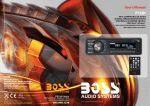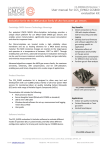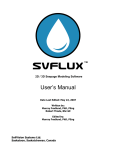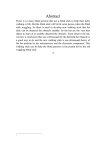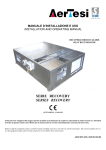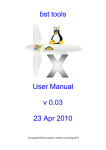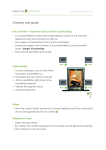Download Details - RegTron
Transcript
Fission Chamber Simulator NFA-09.07 Supplier: KFKI-RegTron Instrumentation & Measuring Co., Ltd. H-1121 Budapest, Konkoly Thege str. 29-33. 1 Contents 1 Introduction 4 2 Principle of Simulation 4 3 Operation 6 3.1 Microcontroller Firmware 6 3.2 PULSE output 7 3.3 AC output 7 3.4 DC output 7 3.5 Control terminal 7 3.6 PC interfacing 3.6.1 Parameter table 3.6.2 Value representation 3.6.3 Commands Issued by the PC and Simulators Reaction to them. 3.6.4 Programming with the Single-Character Commands 8 8 9 10 10 4 Instructions for use 12 5 User manual for the front panel control and display facilities 13 6 Maintenance of the instrument 17 7 TECHNICAL DATA 18 7.1 Neutron Flux Simulation 18 7.2 Pulse Output 19 7.3 DC Output 19 7.4 AC Output 20 Table of figures Block diagram ........................................................................................................................................ 11 Fig. 1 Simulator characteristics ............................................................................................................. 21 Fig. 2 Pulse output signal vs neutron flux characteristics. .................................................................... 22 Fig. 3 AC output signal vs neutron flux characteristics. ........................................................................ 23 Fig. 4 DC output signal vs neutron flux characteristics. ........................................................................ 24 Fig. 5 Power level vs neutron flux characteistics. ................................................................................. 25 Fig. 6 Neutron flux characteristics. ........................................................................................................ 26 Fig.7 Front panel view. .......................................................................................................................... 27 3 1 Introduction The NFA-09.07 Programmable Generator (FCS) is very useful at the calibration of nuclear channels. FCS outputs signals are similar to the nuclear detectors, and it is equipped with programs, making possible to generate different signals necessary for testing, troubleshooting individual elements of the neutron level measurement chain of nuclear instruments. By the aid of this instrument the neutron flux interacted fission chamber put can be simulated very easily. It means that after the reactor and detector parameters are set accurately the signals appear at the pulse, ac and dc outputs follow very well the signals of a real detector. To accomplish this aim FCS produces adjustable test signal levels in the 1.00E+00 to.1.00E+11 nv range on its three outputs (PULSE, AC, DC) according to the diagrams attached to this description (Fig. 1 to Fig. 4). It also calculates the nominal power in % (Fig. 5). The neutron flux time behaviour is either constant or changing exponentially. It means that except of stable state can evoke increase or decrease between two pre selected level value exponentially with a time constant of T.PER (period time) (Fig. 6). Operating parameters of FCS can be set by using the 21-key pad and Vacuum Fluorescent Display (VFD) on the front panel. At the same time PC-control of the generator via an RS232 serial link is also possible. The FCS can be characterized as a programmable pulse generator consisting of Detector Simulator module Detector Signal Output module Terminal module Power Supply 2 NFL-09.20 NFL-04.07 DCL-01.13 NFL-01.09 Principle of Simulation The nuclear reactor is simulated by an internal generator. This generator calculate the temporally value of neutron flux in nv unit. In most reactors the dynamic range of neutron flux is 1.00E+00 to 1.00E+11 nv in detector position. Parameters of detector signals depend on the level of neutron flux. In pulse regime the frequency in ac regime the amplitude of ac current in dc regime the amplitude of dc current follows the nv value according to the following: 1. In pulse regime the frequency of simulated signal depends on the currently neutron flux according to the following: fPULSE = K1 * Φ where fPULSE nominal frequency of pulse output K1 pulse sensitivity of simulated detector Φ simulated neutron flux [Hz] [Hz/nv] 2 [nv=N/m x s] The higher corner point of pulse frequency- neutron flux characteristics (PFLUX1 in Fig. 2) represents the pulse overlapping effects. It means that -depending of the collection time of detector- the output frequency saturates and not able increase its output frequency any more. The amplitude and width of pulses are constant during start period of simulation. FCS allows to set 2 width (0.1 µs/1.5 µs) and 2 amplitude (20 mV/200 mV). The frequency of puse signal is either constants (noiseless) or stochastically changes (noisy).The stochastic signals are generated in digital manner. The frequency spectrum of stochastic signals has the following components: with 0.5 relative weight, 2 f0 f0 with 0.25 relative weight, f0/2 with 0.125 relative weight, etc. 4 2. In ac regime the amplitude of simulated ac current signal depends on the currently neutron flux according to the following: IAC = K2 * √Φ where IAC K2 Φ nominal rms current at ac output ac sensitivity of simulated detector simulated neutron flux [µA] [µA /√nv] 2 [nv=N/m x s] The frequency of ac signal is either constants (noiseless) or stochastically changes causing fluctuation in amplitude (noisy).The stochastic signals are generated in digital manner. A Pseudo-Random Binary Sequence is a periodic, deterministic signal with white-noise-like properties. They are generated using an n bit shift register with feedback through an n exclusive-OR logic. While appearing random in actually the sequence repeats every 2 -1 values. In particular, variations in response signals between two periods of the stimulus can be attributable to noise due to the periodic nature of the signal. Also, like white random binary noise it has an optimal crest factor. The lower corner point of current- neutron flux characteristics (AFLUX0 in Fig. 3) represents the summarized non neutron generated noise (originating in electronic and detector). It means that depending of the non predicted noise signal the output current saturates and not able to decrease its amplitude any more. 5 In dc regime the amplitude of simulated current signal depends on the currently neutron flux according to the following: 3. IDC = K3 * Φ where IDC K3 Φ nominal current of dc output dc current sensitivity of simulated detector simulated neutron flux [µA] [µA /nv] 2 [nv=N/m x s] The lower corner point of current- neutron flux characteristics (DFLUX0 in Fig. 4) represents the summarized non neutron generated current (originating in electronic and detector). It means that the output current saturates and not able to decrease its amplitude any more. The higher corner point of current- neutron flux characteristics (DFLUX1 in Fig. 4) represents the saturation of neutron generated current. It means that the output current saturates and not able to increase its amplitude any more. 3 Operation Operation is explained by the aid of the block diagram (see it on the following page). The FCS consists of two galvanically separated parts: the first part holds the signal generation’s digital functions while the second one contains the output functions. Signal traffic between these parts is affected via optocoupler. 3.1 Microcontroller Firmware Functional block, labelled as dsPIC Microcontroller refers to a RISC-architecture microcontroller type which owns all the features needed to implement the technical specification. It has a high operating speed, hardware-implemented multiplier/divider, 16-bit timers, asynchronous UART, versatile interrupt mechanism and individually oriental I/O pin drivers. All of the functions of the digital parts are controlled by a microcontroller (dsPIC). Among them the Digital Clock Generator (DCG) and the binary Pseudo Noise Generator (PNG), driven by DCG, have leading roles. DCG produces programmable frequency clock signals for PNG in the 1 Hz to 2 MHz range with 0.1 Hz resolution. PNG produces two signal series at its outputs which have a time spectrum very similar to the real nuclear detector signals. One of them results the control of the PULSE signals, and the other of the AC signals.The most important part of the firmware is the method to produce the exponentially increasing or decreasing output levels in time. The firmware issues a new set of operating parameters at constant time increments [e.g. in every 100 ms] which approaches a best fit to the exponential output, [constant time increment method]. The firmware’s backbone is a command interpreter which acts as a mechanism to interpret the set-up parameters, entered by the operator either from a PC terminal or from the built-in 21-key keypad + VFD combination (serial I/O interfacing). After having collected the necessary set of parameters from the mentioned inputs, the firmware enters into the generating phase: it starts sending control sequences to the controlled blocks according to the prescribed time and level requirements. The signal conditioning part is controlled through isolated digital signals. Those are to control of 3 digital-analogue converters, 2 timing signals for pulse and ac outputs, and 3 for controlling dc output resistances. 6 3.2 PULSE output The PNOUT1 signal triggers the programmable monostable multivibrator. The output signal of MMV (PULSE OUT) controls a fast analogue switch (AN MPX), connecting the upper side of the PULSE output’s resistive divider chain alternately to a REF PULSE level and GND. This voltage signal is led through the polarity control stage to the PULSE output. A 20 kΏ external resistor converts the voltage to current. 3.3 AC output The PNOUT2/AC_OUT signal controls a fast analogue switch (AN MPX), connecting the upper side of the AC OUT alternately to a REF AC level and GND. A 200 kΏ external resistor converts the voltage to current. 3.4 DC output The current level of DC OUT can be determinate by the aid of internal or external voltage source and of the choice the sufficient internal resistor. This instrument can implement only noiseless current source. The current level can be set automatically and manually. The required control mode can be set by an 8 positions switch to be found on the front panel of NFL-04.07. • If the RESISTANCE CONTROL switch is in “Aut” position, both the resistance and voltage setting is going on automatically. In this regime the voltage of DAC 3 is lead to the input of 7 tag resistance network. Also automatically is choice the optimal resistance value. • If the RESISTANCE CONTROL switch is in any of the 10 kΏ, 100kΏ, 1 MΏ, 10 MΏ, 100 MΏ, 1 GΏ, 10 GΏ, positions, the labelled resistance connects to the DC output. In this regime the voltage of VOLTAGE IN input is lead to the input of 7 tag resistance network. The voltage setting is going on manually. In most cases the VOLTAGE OUT is connected to VOLTAGE IN connector. A font panel potentiometer controls the voltage level in the range of 0 to 10 V. 3.5 Control terminal The control terminal serves for 1. Setting the simulator parameters. 2. Displaying the current value of computed parameters. 3. Choosing the required page. 4. Start/stop functions. There are 21 knobs, 2 LED-s, a VF display with 4x20 characters to ensure the man-machine interfacing. The control panel has its own microcontroller in order to sove the tasks mentioned above. The microcontroller has a serial I/O stage to ensure data flow between dsPIC and the panel. 7 3.6 PC interfacing Communication between the Simulator and its control-PC is based on a full-duplex, 57.6 kBaud serial channel, using a simple, single-character protocol, corresponding to the MASTER-SLAVE relation, where the Slave is the Simulator, while the Master is always the PC. The serial communication is taking place through RS 232 back panel connector. 3.6.1 Parameter table Parameter table is maintained in Simulator. This table contains all parameters dealing with Firmware Processor (FP) communication. Because the number of parameters exceed 20, it turned out better using an indirect addressing system for them, i.e. instead of having a single character for identifying a parameter’s place in the Simulator’s memory, an ADDRESS and a VALUE mailbox is used to write them one-by-one. The ADDRESS is a relative index, pointing to the actual parameters relative place in the table, while VALUE is its actual value to be written into this address. After having placed a new parameter into this mail-box, issuing a ’W’ command will write it to its place. The following table shows all programmable parameters and its relative addresses. * ** *** Table1 ADDRESS Designation Parameter description 1 2 PFLUX1 The upper corner point of PULSE output in terms of [nv] 3 AFLUX0 The lower corner point of AC output in terms of [nv] 4 5 DFLUX0 The lower corner point of DC output in terms of [nv] 6 DFLUX1 The upper corner point of DC output in terms of [nv] 7 FLUX0 The lower final value of simulated neutron flux in terms of [nv] 8 FLUX1 The higher final value of simulated neutron flux in terms of [nv] 9 K1 Pulse sensitivity in terms of [pps/ nv] A K2 AC sensitivity in terms of [µA/√nv] B K3 DC sensitivity in terms of [µA/nv] C K4 Power factor of reactor in terms of [%/nv] D ACFREQU Nominal frequency of AC output signal in terms of [kHz] E T.PER Exponential variable neutron flux time constant in terms of [s] F STATUS Status expression in terms of bites**** 10 PFREQU Momentary value of PULSE output in terms of [pps] 11 ACURR Momentary value of AC ouput in terms of [µA] 12 DCURR Momentary value of DC output in terms of [µA] 13 FLUX Momentary value of simulated neutron flux in term of [nv] 14 FH Setting of the momentary frequency of PULSE output signal* 15 AC Setting of the momentary amplitude of AC output signal** 16 DC Setting of the momentary amplitude of DC output signal*** The form and meaning of FH parameter value ppppqqqq • pppp period time, (settable range: 2 to 65536 ) • qqqq multiplication factor. Settable range 0..1 közötti értékeket vehet fel, (ha 0001..FFFF ill. 0000..7FFFközötti HEX-értéket adunk meg). The form and meaning of AC parameter value ppppaaaa • pppp period time, (settable range: 2 to 65536) • aaaa amplitude, (settable range: 0000 to FFFF) The form and meaning of DC parameter value xxxxaaaa • xxxx value with no meaning • aaaa amplitude, (settable range: 0000 to FFFF) 8 **** Status 0 STOP FRONT-PANEL 0.1 µs 1 START PC-COMx 1.5 µs AUT MAN B9 B8 B7 B6 B5 B4 B3 CONST INCREASING 20 mV 20 kΩ OFF OFF OFF SWEPT DECREASING 200 mV 200 kΩ ON ON ON B2 B1 B0 (CONT) YES YES (STEP) NO NO B14 B13 B12 B11 B10 Notes The way of inputing parameters PULSE WIDTH FLUX AMPL. PULSE AMPL. Rext-AC R-DC Q4 Q 6 R-DC Q5 L R-DC Q6 L L L H H H H Q 5 L L H H L L H H Q 4 L H L H L H L H R 10kΩ 100kΩ 1MΩ 10MΩ 100MΩ 1GΩ 10GΩ ??? AC NOISE PULSE NOISE A B15...B31 bites are reserves. Default values: 0. 3.6.2 Value representation Floating point numbers are represented in IEEE-754 single precision (32 bit) format. This format allows the floating-point routines to take advantage of the processor architecture and reduce the amount of overhead required in the calculations. The representation is shown below: Format IEEE-754 Exponent sxxx xxxx Mantissa 0 yxxx xxxx Mantissa 1 xxxx xxxx Mantissa 2 xxxx xxxx where s is the sign bit, y is the lsb of the exponent x placeholder for the mantissa and exponent bits. It needs to be mentioned that both numbers are organised in “big endian” order. Therefore the representation shows from the left hand side to the right the starting with the highest value and the lowest byte takes place on the right-wring. The following calculator hyperlink helps converting decimal number to IEEE-754 single precision (32 bit) format http://babbage.cs.qc.edu/IEEE-754/Decimal.html An example is to be found in Appendix 1. It can be read that the 6.32E-05 decimal number is equivalent to 38848A3E hex in 32 bits IEEE 754 format. 9 3.6.3 Commands Issued by the PC and Simulators Reaction to them. These are basically single-character commands without any checksum or control character companions. The verification of the commands correct interpretation is the operators observation of the expected reaction on the screen. (The main cause of this approach was originally the wish of shortening message traffic as much as possible). The commands: ’S’ Start emitting simulated outputs ’P’ Stop ’r’ Send actual STATUS, PFREQU, ACURR, DCURR and FLUX values to PC in a single line, ending with an ’*’. ’W’ write parameter from the mail-box to its place in parameter table ’d’ dump parameters Dumps parameter table, maintained in Simulator. This table contains all parameters defined in document (see Table1) dealing with FP-communication. The table entries -which are 4-byte hexadecimal numbers, separated by space and CR/LF characters- end with a ’$’ symbol. To maintain the ’single-character command’ feature, later we adopted a mechanism by which one can transfer binary bytes to the Simulator by using the special ’L’ command. This one notes the FW in the simulator, that the next command will be a binary byte (instead of an ASCII character). This way sending e.g. a status-word (a two-byte value) looks like that: ’M’ ’L’ adbyte1 ’L’ adbyte2 ’V’ ’L’valbyte1 ’L’ valbyte2 ’L’ valbyte3 ’L’ valbyte4. Where ’M’ and ’V’ adbytex (2 bytes long) valbytey ( bytes long). pointer-setting commands, the binary address bytes to be transferred into the parameter-table. the binary value bytes to be transferred into the parameter-table. 3.6.4 Programming with the Single-Character Commands By using the handful of simple commands described in 3.6.3 one can easily write a shell-program to control the simulator via RS 232 connector. The only precondition to this understands the working of the Simulator on the ground of the main parameters, with special care of the Status Word. After this one has to send • the application‘s controlling parameters (as many MLLVLLLL-sequences each is followed by W as are parameters to change) • Review them in a text-box (send ‘d’ command) • Finally start (‘S’). 10 ICS2 IDIN ICLK REF_PULSE 20k RANGE 2:25 AGND AGND AGND 0,1/1,5us + PNOUT1 MCKL DSCLK PULSE_OUT XCLK - CKSW AGND PNOUT2 AC_OUT SOM ICS3 IDIN ICLK SQW ICS3 ICS3 ICS3 IDIN ICLK 5 200k REF_AC AGND AGND ICS1 IDIN ICLK DC_OUT 10k, 100k. 1M, 10M,100M, 1G,10G AGND AGND 3 3 5 Block diagram 11 4 Instructions for use The operation of the simulator has the following steps: 1. In order to select the suitable parameters the characteristics of the simulated nuclear reactor, detector and signal processor needs to be collected. What needs to be specified are as follows: a. K4 [%/ny]: the relationship between neutron flux measured on the position of detector and the nuclear power supplier performance b. From the simulated detector’s catalogue data originated parameters which can be seen in the table below Measurement mode Impulse Name Sensitivity The upper corner point of linear range Signal amplitude Signal width Parameter Marking [Unit of measure] Setting range K1 [pps/nv] PFLUX1 [nv] 1.0E-01 to 1.0E+01 1.0E+03…1.0E+07 PULSE AMPL [mV] PULSE WIDTH [µs] 20, 200 0.1, 1.5 AC Sensitivity The lower corner point of linear range K2 [µA/√nv] AFLUX0 [nv] × 1.0E-06…1.0E-03 1.0E+02…1.0E+05 DC Sensitivity The lower corner point of linear range The upper corner point of linear range K3 [µA/nv] DFLUX0 [nv] 1.0E-11…1.0E-05 1.0E+02…1.0E+11 DFLUX1 [nv] 1.0E+02…1.0E+11 × The value of K2 scaling factor can be calculated from the following formula K2=√(S.B) Where K2 S B c. × Scaling factor of AC signal [µA/√nv] 2 Neutron sensitivity of detector in fluctuating mode [A /Hz*nv] Bandwidth of processing part [Hz] Bandwidth of the band-pass filters B [Hz] using in the AC (Campbell) channel. This parameter is needed to calculate K2 parameter 2. The device can be switched on with the POWER ON switch from the front end. 3. Connecting the resistance probes to the PULSE and the AC connectors. As a start • To the PULSE connector a 20 kΏ probe• To the AC connector a 200 kΏ probe needs to be connected. 4. Inserting the parameters acquainted (above in the point number 1) can be execute in two ways: • Through the device’ front end control and display facilities. • Through a RS 232 serial port 5. Inserting the parameters that needs to simulate the nuclear reactor (listed on the display, p. 1). 12 6. Setting the AC signals’ nominal frequency (ACFREQU). Most of the time it needs to be set as 50kHz. 7. The PULSE and the AC output’s noise property settings. PULSE NOISE The PULSE output signal frequency Noisy(Y)/ Constant (N) AC NOISE The AC output signal amplitude. Noisy(Y)/ Constant (N) 8. The DC DESISTANCE CONTROL switch needs to be set to AUT. 9. The simulation can be start with pressing the START button 5 User manual for the front panel control and display facilities For the device’ human and electronic interaction a 21button keyboard and a VF display (4 row, 20 characters/row) are responsible. The keyboards’ keys are arranged in the following way: 0…9 The setting of the value of the marked parameter The setting of the marked parameter exponent polarity The adjustable parameter marker cursor moving key The parameter activator that was marked with the cursor Exiting the parameter marked with the cursor without amending it. The execution of the amendment of the parameter marked by the cursor Starting the simulator Exiting the simulator The key that is responsible for changing the 4 row view (page) on the display +/↑ , ↓,←,→ SET ESCAPE ENTER START STOP PAGE UP Using the PAGE UP key the following parameters can be selected which can be viewed on the pages: 1. page Parameters to set the neutron flux in time order F F F T L L L . FLUX U U U P X X X E 0 1 R : : : : X X X X . . . . X X X X X X X X E E E E FLUX0 The momentary value of the simulated neutron flux The lower final value of the neutron flux FLUX1 The higher final value of the neutron flux T.PER Exponential variable neutron flux time constraint after the START command selected 13 X X X X X X X X X X X X n n n v v v s Calculated parameter Parameter that needs to be set Parameter that needs to be set Parameter that needs to be set The momentary signals that can be seen on the simulators PULSE, AC and DC outputs depend on the simulated neutron flux current value. Before giving the START command the neutron flux either provides the previous cycle FLUXO/FLUXI final value or it stagnates on the value at the moment on the STOP command given. After giving the START command the, neutron flux timing can be set with the FLUX0, FLUX1, T.PER and FLUX AMPL parameters according to the following: (See Fig. 6.) • • • If the FLUX AMPL=CONST in this case the neutron flux is stagnated on the FLUXO parameters level. If the FLUX AMPL=INCR, the neutron flux effects the new cycle in a way, that from the value that was standardised in the previous cycle with T PER time constant increasing exponentially. If the STOP command is launched before the FLUX1 value is reached the neutron flux is stabilised at the moment when the command is given. In the case when STOP command is not launched the neutron flux is increasing until it reaches FLUX1 value and after it remains stable. If the FLUX AMPL=DECR, the neutron flux effects the new cycle in a way, that from the value that was standardised in the previous cycle with T PER time constant decreasing exponentially. If the STOP command is launched before the FLUX0 value is reached the neutron flux is stabilised at the moment when the command is given. In the case when STOP command is not launched the neutron flux is decreasing until it reaches FLUX0 value and after it remains stable. 2. page. Displaying the momentary power and current and setting theDC characteristic corner value Display P W R D C U D F L D F L PWR DCURR DFLUX0 DFLUX1 R U U R X X 0 1 : : : : X X X X . . . . X X X X X X X X E E E E The momentary value of the simulated power PWR=K4*FLUX The simulated current momentary value DCURR= K3*FLUX The DC characteristics’ bottom corner point (see on Fig. 4.) The DC characteristics top corner point (see on Fig. 4.) 14 X X X X X X X X X X X X µ n n % A v v Calculated parameter Calculated parameter Parameters that needs to be set Parameters that needs to be set 3. page Displaying the momentary impulse frequency and the AC current, setting the impulse and AC characteristics corner points Display F P A A R F C F E L U L FREQU PFLUX1 ACURR AFLUX0 Q U R U U X R X : : : : 1 0 X X X X . . . . X X X X X X X X E E E E X X X X The simulated impulse frequency momentary value FREQU=K1*FLUX The PULSE characteristics top corner point (see on Fig. 2.) The simulated AC signals’ amplitudes’ momentary value AFLUX =K2*FLUX The AC characteristics top corner point (see on Fig. 3.) 4. page X X X X X X X X p p n µ n s v A v Calculated parameter Parameters that needs to be set Calculated parameter Parameters that needs to be set to be set The detector and the nuclear reactor’s sensitivity parameters Display K K K K K1 1 2 3 4 : : : : X X X X . . . . X X X X X X X X E E E E X X X X X X X X X X X X p µ K2 The detectors’ sensitivity in pulse work of operation The detectors’ sensitivity in AC work of operation K3 The detectors’ sensitivity in DC work of operation K4 Power factor 15 p A µ s / A % / √ / / n n n n Parameters needs to be set Parameters needs to be set Parameters needs to be set Parameters needs to be set v v v v that that that that 5. page. Unclassified parameters Display A R R F C i e L F n x U R t t X E - Q D A U C C A : : : M P X X . . L . X X 2 X X 0 : E E 0 X X X X X X c o n ACFREQU The AC outputs’ signal nominal frequency Rint-DC Resistance connected to the DC output (internal) Resistance connected to the AC output (external) Setting of the neutron flux’ timing parameters Rext-AC FLUX AMPL* • • • • s H Ω k t z Ω . Parameters that needs to be set Displayed parameter Parameters needs to be set Parameters needs to be set that that *A FLUX AMPL parameters that can be set CONST START after on the neutron flux FLUXO remains the same INCR START after the neutron flux is increasing from the previous cycles’ level exponentially until the STOP command but the maximum is the FLUX1 level DECR START after the neutron flux is decreasing from the previous cycles’ level exponentially until the STOP command but the maximum is the FLUX0evel The PULSE and the AC output signal parameters 6. page Display P P P A U U U C L L L S S S PULSE AMPL PULSE WIDTH PULSE NOISE AC NOISE E E E A W N N M I O O P D I I L T S S . H E E : : : : The PULSE output signal amplitude 20 mV/200mV The PULSE output signal width 100 ns/2 µs The PULSE signal output frequency Noisy(Y)/Constant (N) The AC output signal amplitude Noisy(Y)/ Constant(N) 16 X X y y X . e e X X s s m µ Parameters needs to be set Parameters needs to be set Parameters needs to be set Parameters needs to be set V s that that that that 6 Maintenance of the instrument Inside the device, heat-removal has to be provided, hence the heat sinks of the modules, the ferrite elements and their surroundings have to be cleaned annually (in a dusty environment more often, if necessary). While cleaning, check visually the modules and the connecting cables. Clean the display and the device controls with a wet cloth rubbing carefully. The instrument does not require other maintenance. The free distance for the instrument top and bottom is minimum 1U (1,75 inch). Only a qualified person can do these works. The modules can be removed from the device only one minute after switch-off from front side. If necessary, but at least annually the main parameters of the instrument should be checked as it is described in attached testing reports. In case of malfunction is expected first contact Regtron Ltd describing the phenomenon. Our experts take advices the way of repair. In worst case after removing of module(s) customer have to send it back to Regtron site to repair it. The life protection earth has to be checked in prescribed periods, but at least annually. The same applies to the instrument and the whole of the measuring assembly. 17 7 TECHNICAL DATA Signals Generated: Different outputs operate simultaneously. Output levels are set always by the (preset) nv values. 7.1 Neutron Flux Simulation Neutron flux range Time function Exponential signal parameters Starting level FLUX0 Stopping level FLUX1 Time constant T.PER * Neutron flux to power conversion Scaling factor PW (K4) 1.00E+00 to 1.00E+11 nv Constant or exponential 1.00E+00 to FLUX1 nv FLUX0 to 1.00E+11 nv 1.00E+01 to 1.00E+02 s settable settable 1.00E-09 to 1.00E-07 %/nv settable settable *Time constant for AC output always twice as much as for Pulse and DC one. The OPERATING MODES and other programmable parameters (e.g. output pulse amplitude, pulse frequency) can be selected by program. The following table shows in summarized form all the possible operating modes connected with the necessary parameter settings. Operation mode 0 1 PULSE OUT AC OUT DC OUT Fixed frequency, Fixed amplitude. Fixed average frequency, Fixed amplitude Fixed frequency, Adjustable amplitude Fixed average frequency, Adjustable amplitude Adjustable DC value 2 Exponentially frequency, Fixed amplitude. 3 Exponentially average frequency Fixed amplitude swept Exponentially swept frequency, Amplitude follows the rootsquare rule. swept Exponentially swept average frequency, Amplitude follows the rootsquare rule. 18 Adjustable DC value Exponentially swept DC value Exponentially swept DC value 7.2 Pulse Output Scaling factor K1 Frequency Range Resolution Time distribution Higher corner point PFLUX1 Pulse Width Amplitude Polarity Stability (8 hours) Connector type 7.3 1.00E-01 to 1.00E+01 pps/nv 1 pps to 2 Mpps Max 1.00E-04 pps (at 1 pps) Max 1.00E+02 pps (at 2 Mpps) Periodic, stochastic 1.00E+03 to 1.00E+07 nv 0.1 µs / 1.5 µs pulses 20mV/200 mV (at 20 kΏ load) + or - (selectable) settable settable selectable selectable Width: ± 0. 5 % Amplitude: ± 1 % BNC DC Output Scaling factor K3 Signal type Amplitude range Amplitude resolution Serial resistance Lower corner point DFLUX0 Higher corner point DFLUX1 Integral linearity Stability (8 hours) Connector type 1.00E-11 to 1.00E-05 µA/nv Direct current 10 mV- 10 V 16 bits 10 kΏ, 100 kΏ, 1 MΏ, 10 MΏ, 100 MΏ, 1 GΏ, 10 GΏ (selectable) 1.00E+02 to 1.00E+11 nv (settable) 1.00E+02 to 1.00E+11 nv (settable) < ± 0.1 % of Full Scale ± 0.25 % BNC 19 7.4 AC Output Scaling factor K2 Signal type Amplitude range Amplitude resolution Nominal frequency AFREQU Serial resistance Lower corner point Integral linearity Stability (8 hours) Connector type AFLUX0 1.00E-06 to 1.00E-03 µA/√nv settable Pulses with settable amplitude. 10mV to 10V 16 bits 1.00E+04 to 5.00E+04 pps settable Stochastic or periodic 200 kΏ (external) 1.00E+02 to 1.00E+05 nv settable < ± 0.1 % of Full Scale ± 0.25 % (amplitude) BNC The value of K2 scaling factor can be calculated from the following formula K2=√(S.B) Where K2 Scaling factor of AC signal [µA/√nv] 2 S Neutron sensitivity of detector in fluctuating mode [A /Hz*nv] B Bandwidth of processing part [Hz] In the following table K2 is calculated-as examples- for three different detectors and with tree different bandwidths. Detector type CFUG 08 CFUL 08 CFUM 18 Neutron sensitivity 2 [A /Hz*nv] Bandwidth [Hz] 5.00E+04 K2 [µA/√nv] 8.94E-05 4.47E-05 1.41E-05 1.60E-25 4.00E-26 4.00E-27 20 1.00E+05 2.00E+05 1.26E-04 6.32E-05 2.00E-05 1.79E-04 8.94E-05 2.83E-05 Simulator output signal vs neutron flux K1= 1.0 [pps/nv] K2= 6.32E-05 [µA/√nv] K3= 2.00E-07 [µA/nv] 1.00E+04 1.0E+06 1.00E+03 Pulse rate [ pps ] PFLUX1 DFLUX1 1.00E+02 Pulse 1.0E+04 AC 1.00E+01 1.0E+02 1.00E+00 1.00E-01 1.0E+00 AFLUX0 1.00E-02 DFLUX0 1.0E-02 1.00E-03 1.0E-04 1.0E+00 1.0E+01 1.0E+02 1.0E+03 1.0E+04 1.0E+05 1.0E+06 Neutron flux[nv] Fig. 1 Simulator characteristics 1.0E+07 1.0E+08 1.0E+09 1.0E+10 1.00E-04 1.0E+11 AC current [ µA ], DC current [ µA ]; DC Pulse output signal vs neutron flux PLS (K1)= 1.0 [pps/nv] PFLUX1=1.00E+06 nv PFLUX1 Nominal pulse rate [pps] 1.0E+06 1.0E+04 1.0E+02 1.0E+00 1.0E+00 1.0E+01 1.0E+02 1.0E+03 1.0E+04 Neutron flux[nv] Fig. 2 Pulse output signal vs neutron flux characteristics. 1.0E+05 1.0E+06 1.0E+07 ACoutput signal vs neutron flux K2= 6.32E-05 [µA/√nv] AFLUX0=1.00E+03 1.0E+01 1.0E+00 AC current [µA] 1.0E-01 1.0E-02 AFLUX0 1.0E-03 1.0E+00 1.0E+01 1.0E+02 1.0E+03 1.0E+04 1.0E+05 1.0E+06 Neutron flux [nv] Fig. 3 AC output signal vs neutron flux characteristics. 1.0E+07 1.0E+08 1.0E+09 1.0E+10 1.0E+11 DC output signal vs neutron flux K3= 2.00E-07 [µA/nv] 1.0E+04 DFLUX1 1.0E+03 DC current [µA]; 1.0E+02 1.0E+01 1.0E+00 1.0E-01 1.0E-02 DFLUX0 1.0E-03 1.0E-04 1.0E+00 1.0E+01 1.0E+02 1.0E+03 1.0E+04 1.0E+05 1.0E+06 Neutron flux[nv] Fig. 4 DC output signal vs neutron flux characteristics. 1.0E+07 1.0E+08 1.0E+09 1.0E+10 1.0E+11 Neutronflux vs PN% K4= 1.00E-08 [PN%/nv] 1.0E+11 1.0E+10 1.0E+09 Neutron flux [nv] 1.0E+08 1.0E+07 1.0E+06 1.0E+05 1.0E+04 1.0E+03 1.0E+02 1.0E+01 1.0E+00 1.0E-08 1.0E-07 1.0E-06 1.0E-05 1.0E-04 1.0E-03 1.0E-02 Pow er [ PN%] Fig. 5 Power level vs neutron flux characteistics. 1.0E-01 1.0E+00 1.0E+01 1.0E+02 1.0E+03 Neutron flux simulation FLUX0=1.00E+03, FLUX1=1.11E+04, T.PER= 1.00E+01 DECR, START AUTO STOP FLUX1 Netron flux [nv] STOP CONST, START STOP INCR, START FLUX0 FLUX0 STOP INCR, START INCR, START Time [s] Fig. 6 Neutron flux characteristics. AUTO STOP Fig.7 Front panel view.






























